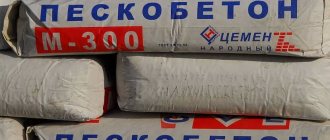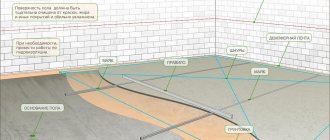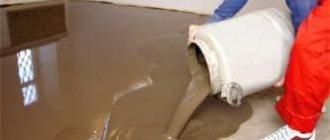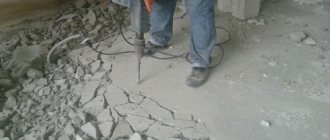In construction, expanded clay is one of the most popular materials. To insulate floors, floors, walls and make screeds, it is purchased in very large volumes, and it is not uncommon for some of the material to remain unused. In order not to create such problems for yourself and not to overpay for excess or additional delivery, it is advisable to calculate the expanded clay for floor screed before starting work. A calculator for such calculations is available on the websites of most supplier companies. To obtain the desired result, you only need to insert known design parameters into the corresponding lines.
To avoid counting by hand, use an online calculator Source twimg.com
Data for calculation
Screeds with expanded clay are different.
- Dry screed is a simple pouring of material onto the base with compaction and leveling.
- A lightweight screed on a leveling bedding involves installing a sand concrete covering over a layer of expanded clay.
- To produce a “wet” screed, expanded clay is introduced into the concrete as a filler.
In all cases, you should use a different expanded clay calculator, and to obtain accurate results you need to know the technology for making a particular screed.
In principle, you can determine the required amount of materials using formulas, but an online calculator will do this much faster and without random errors.
To calculate expanded clay per 1 m2, the calculator in all cases will definitely request the following input data:
- the length and width of the room or its total area;
- thickness of the screed or backfill under it;
- expanded clay fraction (grain size).
Depending on the type of screed and the technology for its manufacture, the program will need some other parameters.
Technological features
The process of preparing expanded clay mixture has some peculiarities. And its final characteristics will depend on the proportion of its constituent components. When using different volumes of water, you can prepare a liquid, semi-dry or dry solution.
Wet method
The advantage of liquid mortar is self-leveling. In this case, all the expanded clay granules float up and the heat-insulating layer is located in the upper part of the floor screed.
The disadvantage of the wet pouring method is the need to perform an additional concrete screed under the finishing coating of the base. This requires additional time and increases the cost of work.
The wet method is only suitable for insulating the floors of attics and outbuildings. Concrete mortar, which includes expanded clay, is recommended for use in reinforced concrete blocks.
Semi-dry method
The consistency of the working mixture makes it possible to distribute expanded clay evenly throughout the entire volume of the screed. The technique can be used to fill foundations of any material.
Disadvantages of semi-dry solution:
- pouring requires great physical effort from workers;
- the need to use beacons for high-quality work;
- The finished surface must additionally be sanded.
Dry screed
This technology does not involve mixing the solution. Dry expanded clay is laid directly on the floor base, and a thin layer of standard cement mortar is poured on top of it.
Today on the construction market you can purchase ready-made dry mixtures in which the proportions of the necessary components are maintained. This greatly simplifies the preparation of solutions for filling floors.
Calculation for dry screed
The basis of the dry screed is a backfill of fine expanded clay, which has a density of about 1500-1700 kg/m3.
The process of creating dry expanded clay screed Source dumazahrada.cz
After compaction and creation of an even horizontal level along the guides, gypsum fiber sheets with stepped edges are laid on top of the dry screed, ensuring tight joining of the elements and creating a continuous surface for laying the final coating.
To determine the consumption of expanded clay for floor screed per 1 m2, the calculator will ask for standard data - the area of backfill and the height to which the floor level needs to be raised. The density of the screed is usually already included in the calculation algorithm.
But there is a nuance here: the height does not mean the thickness of the expanded clay layer, but the general difference between the existing base and the future gypsum fiber board coating.
The program independently takes into account certain features of the technology when making calculations.
- If the height of the dry screed does not exceed 100 mm, it is made in one layer and consists of the thickness of this layer and the thickness of the gypsum fiber sheet (20 mm).
- If the height is more than 100 mm, then the screed is made in two layers with the separation of gypsum plasterboard, the total thickness of which in the screed will be 40 mm.
Note! If the height of the dry expanded clay backfill is more than 80 mm without a separating layer, even with high-quality compaction, it may turn out to be too mobile.
Enter the total height to which the floor level will rise in the calculator line Source zabor.bz
See also: Catalog of companies that specialize in finishing materials and related work
Since the initial base is rarely level, the thickness of the dry screed differs in different places. Therefore, when calculating the consumption of expanded clay per 1 m2, the program takes into account the need to level out differences in height and makes the calculation by adding 5-10% of the material to the “net” result.
Approximate ratio of ingredients in the manufacture of expanded clay concrete
When preparing expanded clay concrete mortar, it is important to maintain proportions . For example, if you use M400 cement, then you need about 4-5 buckets of expanded clay. If the fraction is large, then more buckets are needed. 3-4 buckets of sand and one bucket of cement are added to the expanded clay. The dry ingredients are filled with about one and a half buckets of water.
| Concrete grade by average density / expanded clay grade by bulk density | Cement, kg | Expanded clay, m3 | Sand, kg |
| 1500/700 | 430 | 0,8 | 420 |
| 1600/600 | 430 | 0,68 | 680 |
| 1600/700 | 400 | 0,72 | 640 |
| 1700/600 | 410 | 0,56 | 880 |
| 1700/700 | 380 | 0,62 | 830 |
If you need a dense solution, then you should add fine-grained expanded clay. A plasticizer, for example, liquid soap, must be poured into the expanded clay concrete mixture.
How to check the density of a solution:
- Take a shovel.
- Scoop up the solution.
- Look at the hill that has formed on the shovel.
- If it crumbled, then the building material turned out to be very liquid and it is unsuitable for use in construction.
- If the slide turns out to be stable, then the solution is good and can be used for work.
Calculation for a “wet” screed
Adding expanded clay instead of crushed stone to concrete has many advantages, the main of which are reducing the weight of the rough coating and increasing its thermal insulation characteristics. This is especially important for private houses with wooden floors that are not designed for high loads.
First of all, to determine the amount of all materials, you will need to know the thickness of the expanded clay concrete screed. It depends on the level differences across the entire area being poured, but should not be less than 40 mm, since a layer of less thickness often cracks.
Why choose expanded clay concrete?
- Blocks made from this material have a lower cost than other building materials.
- They are superior in strength to aerated concrete and foam concrete.
- To build a multi-story house from expanded clay blocks, you do not need to make a frame.
- Ready-made expanded clay concrete blocks have low water absorption and thermal conductivity.
- In terms of service life, expanded clay blocks are approximately on the same level as bricks.
- In addition to high performance characteristics, it is worth noting that expanded clay blocks do not mold.
- Expanded clay concrete blocks meet all the requirements that wall materials must meet.
- Buildings are constructed quickly from expanded clay concrete.
- Any finishing materials can be used inside.
- When using expanded clay concrete blocks for construction, a lightweight foundation is sufficient, so you can save money.
Video description
How to take accurate measurements to determine the thickness of a warm screed, see the video:
On a note! If there is a cold subfloor or unheated basement under the floor of the first floor, it is advisable to increase the thickness of the screed to 8-10 cm.
In the expanded clay calculator for floor screed, in addition to the planned layer thickness, the area of the leveled surface and the fraction of the material used, you will need to enter additional parameters:
- brand of cement used;
- the required grade of concrete strength.
This data is necessary to produce a screed with certain strength characteristics, which requires precise adherence to the dosage of each component included in the solution.
In some programs, the calculation algorithm also includes other parameters, for example, the brand of plasticizer and other additives. Others additionally determine the consumption of accompanying materials, for example, metal mesh for screed reinforcement.
Note! Most online calculators calculate the consumption of expanded clay of a fraction of at least 10 mm. If you use expanded clay sand, which has a higher density, the automatic calculations may be incorrect.
The size of expanded clay sand granules is 0-5 mm Source keramzit-aleksin.ru
Preparatory work
To get the desired result of leveling the floor, you need to properly prepare the base.
This process consists of sequential actions:
Installation diagram of beacons for floor screed made of metal profiles.
- All furniture, carpets and curtains are removed from the premises.
- Using a nail puller, the old flooring is removed and removed.
- The old screed is separated from the concrete slab. As a rule, it has already outlived its usefulness, cracked and crumbled.
- Crushed concrete, dust and debris are removed from the cracks between the wall panel and the floor slab. This is done with a brush and vacuum cleaner.
- The existing cracks on the slab are expanded, treated with a primer and sealed with cement mortar.
- Sealant is placed in the cracks between the floor slab and the wall blocks.
- After the sealant has hardened, the remaining holes are sealed with starting putty.
- The casing holes through which heating, water or sewer pipes pass are cleared.
- Heat-resistant sealant is placed in them, and the holes are closed with putty material.
- The surface of the concrete slab and partially the walls (up to a height of 10 cm) is treated with a special impregnation for concrete. It must be applied at least 2 times.
This is necessary to ensure that water from the expanded clay concrete is not absorbed into the floor slab. Dry concrete won't do much good. The surface should dry within 24 hours, after which you can proceed to marking the surface.
Benefits of using online calculators
The simplest programs have a standard algorithm and only produce calculation results for the weight or volume of materials. But serious companies engaged in repair and construction work usually use certain proven types of expanded clay and related materials for screeding. They create advanced calculators with which you can obtain data on the consumption of all screed components, as well as find out the total cost of materials and work, taking into account their delivery to the site.
Material properties
It is made from special types of clay, which are dried, crushed, cleaned of impurities, and then molded into granules. As a result of high-temperature treatment, they acquire porosity and extraordinary lightness. Thus, the technical characteristics of the material are determined by the properties of natural raw materials, as well as the characteristics of the manufacturing process.
Given its ability to retain heat well, expanded clay backfill is often used as insulation for roofing and interior partitions. Its thermal conductivity ranges from 0.07-0.16 W/m*C: slightly worse than that of mineral wool and expanded polystyrene (penoplex), but better than that of brick and reinforced concrete. In addition, expanded clay is cheaper than traditional thermal insulators, which makes it even more attractive for developers.
Burnt clay granules have high strength and therefore are able to withstand significant loads, but in bulk form they have a non-solid structure. To use them as a finishing layer, they must be additionally compacted with something.
antifungal agent for wall treatment
Good sound absorption allows the use of such backfill as a means of noise suppression. This property is in great demand in individual construction, as well as when renovating apartments. It is not surprising that ceramic stones are often used for soundproofing homes.
Despite their natural origin, they do not rot and are not of interest to rodents. In addition, the material does not support combustion and does not emit toxic substances when exposed to an open flame.
Briefly about the main thing
In order not to waste precious time on complex calculations, risking making a mistake or not taking into account some important parameters, it is better to use special construction calculators. With their help, you can calculate the consumption of not only expanded clay for dry and wet screeds, but also all other basic and consumable materials for its manufacture.
Such programs require entering known parameters into the appropriate fields - floor area, screed height and expanded clay fraction used, after which they instantly produce ready-made results taking into account the required margin.
How to make a floor screed with expanded clay: a review of 3 options
Expanded clay is a well-known material with remarkable consumer properties. It is widely used in construction and repair: for insulating walls and foundations, as inexpensive sound insulation, and also in the manufacture of a rough base for finishing flooring. Let's figure out what it is, how a floor screed with expanded clay is laid and how complex the technology is.
Expanded clay - what is it?
We are absolutely sure that anyone over 10 years old knows the mysterious word “expanded clay.” Many people believe that this is some kind of building material, or drainage felts, or plant bait, or something else... But few will answer the simple question: what is expanded clay? It will be difficult, and please describe the properties of this material. The range of applications is so wide that listing them would take a lot of time. It remains a big mystery where expanded clay is mined or maybe it is produced? And if they are made, then from what?
Increasingly, when reviewing heat-insulating materials that have literally flooded our construction markets, the keywords for description are: new, modern, innovative, and so on. Indeed, the quantity, variety, and most importantly the high quality of numerous materials has recently become more and more surprising and pleasing.
Today we will talk about material that is well known from childhood. Let us, so to speak, eliminate the gaps in knowledge. Indeed, expanded clay is primarily a building material, which often finds its use outside the construction site. People who are very far from construction sites sometimes encounter expanded clay balls.











